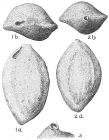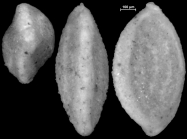WoRMS taxon details
Sigmoilopsis Finlay, 1947
112044 (urn:lsid:marinespecies.org:taxname:112044)
accepted
Genus
Sigmoilina schlumbergeri Silvestri, 1904 accepted as Sigmoilopsis schlumbergeri (Silvestri, 1904) (type by original designation)
- Species Sigmoilopsis arenaria (Brady, 1884)
- Species Sigmoilopsis arenata (Cushman, 1921)
- Species Sigmoilopsis carinata Zheng, 1988
- Species Sigmoilopsis celata (Costa, 1855)
- Species Sigmoilopsis chapmani (Cushman, 1946)
- Species Sigmoilopsis elliptica (Galloway & Wissler, 1927)
- Species Sigmoilopsis finlayi Vella, 1957
- Species Sigmoilopsis flintii (Cushman, 1946)
- Species Sigmoilopsis herzensteini (Shlumberger, 1894)
- Species Sigmoilopsis minuta (Collins, 1958)
- Species Sigmoilopsis moyi Atkinson, 1968
- Species Sigmoilopsis obesa Zheng, 1988
- Species Sigmoilopsis orientalis Zheng, 1988
- Species Sigmoilopsis procericollis Mikhalevich, 1977
- Species Sigmoilopsis revetocollaris Loeblich & Tappan, 1994
- Species Sigmoilopsis schlumbergeri (Silvestri, 1904)
- Species Sigmoilopsis venius Saidova, 1975
- Species Sigmoilopsis wanganuiensis Vella, 1957
- Species Sigmoilopsis woodi Atkinson, 1968
- Species Sigmoilopsis asperula (Karrer, 1868) accepted as Spiroglutina asperula (Karrer, 1868)
- Species Sigmoilopsis moyi Atkinson Em. Haynes, 1973 accepted as Sigmoilopsis moyi Atkinson, 1968
- Species Sigmoilopsis tenuis (Cžjžek, 1848) accepted as Spirosigmoilina tenuis (Cžjžek, 1848) (unaccepted > superseded combination)
marine, brackish, fresh, terrestrial
recent + fossil
feminine
Finlay, H. J. (1947). New Zealand Foraminifera: Key Species in Stratigraphy - No. 5. <em>New Zealand journal of science and technology.</em> B28: 259-292.
page(s): p. 270 [details]
page(s): p. 270 [details]
Hayward, B.W.; Le Coze, F.; Vachard, D.; Gross, O. (2024). World Foraminifera Database. Sigmoilopsis Finlay, 1947. Accessed through: World Register of Marine Species at: https://marinespecies.org/aphia.php?p=taxdetails&id=112044 on 2024-11-21
Date
action
by
![]() The webpage text is licensed under a Creative Commons Attribution 4.0 License
The webpage text is licensed under a Creative Commons Attribution 4.0 License
original description
Finlay, H. J. (1947). New Zealand Foraminifera: Key Species in Stratigraphy - No. 5. <em>New Zealand journal of science and technology.</em> B28: 259-292.
page(s): p. 270 [details]
basis of record Gross, O. (2001). Foraminifera, <B><I>in</I></B>: Costello, M.J. <i>et al.</i> (Ed.) (2001). <i>European register of marine species: a check-list of the marine species in Europe and a bibliography of guides to their identification. Collection Patrimoines Naturels,</i> 50: pp. 60-75 (look up in IMIS) [details]
additional source Loeblich, A. R.; Tappan, H. (1987). Foraminiferal Genera and their Classification. Van Nostrand Reinhold Company, New York. 970pp., available online at https://books.google.pt/books?id=n_BqCQAAQBAJ [details] Available for editors [request]
[request]
page(s): p. 270 [details]
basis of record Gross, O. (2001). Foraminifera, <B><I>in</I></B>: Costello, M.J. <i>et al.</i> (Ed.) (2001). <i>European register of marine species: a check-list of the marine species in Europe and a bibliography of guides to their identification. Collection Patrimoines Naturels,</i> 50: pp. 60-75 (look up in IMIS) [details]
additional source Loeblich, A. R.; Tappan, H. (1987). Foraminiferal Genera and their Classification. Van Nostrand Reinhold Company, New York. 970pp., available online at https://books.google.pt/books?id=n_BqCQAAQBAJ [details] Available for editors
 Present
Present  Inaccurate
Inaccurate  Introduced: alien
Introduced: alien  Containing type locality
Containing type locality
From editor or global species database
Diagnosis Test ovate in outline, chambers one-half coil in length, with rapidly changing planes in the early stage resulting in two spiralling series that appear sigmoid in section, gradually becoming planispiral in the adult, chambers with floors, chamber lumen narrow; wall thick, porcelaneous but enclosing a large quantity of agglutinated quartz particles, sponge spicules, and shell fragments; aperture terminal, rounded, with a small tooth. Miocene to Holocene; Europe; Atlantic; Caribbean; Australia; New Zealand. (Loeblich & Tappan, 1987, Foraminiferal Genera and Their Classification) [details]



